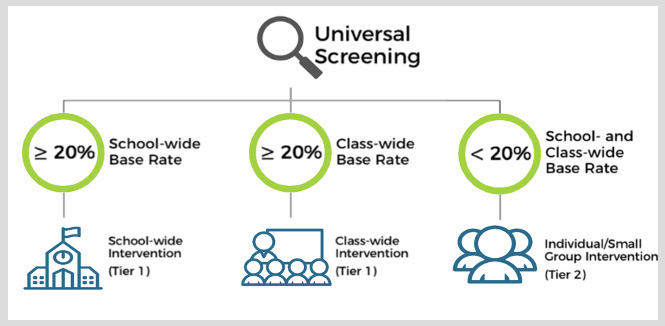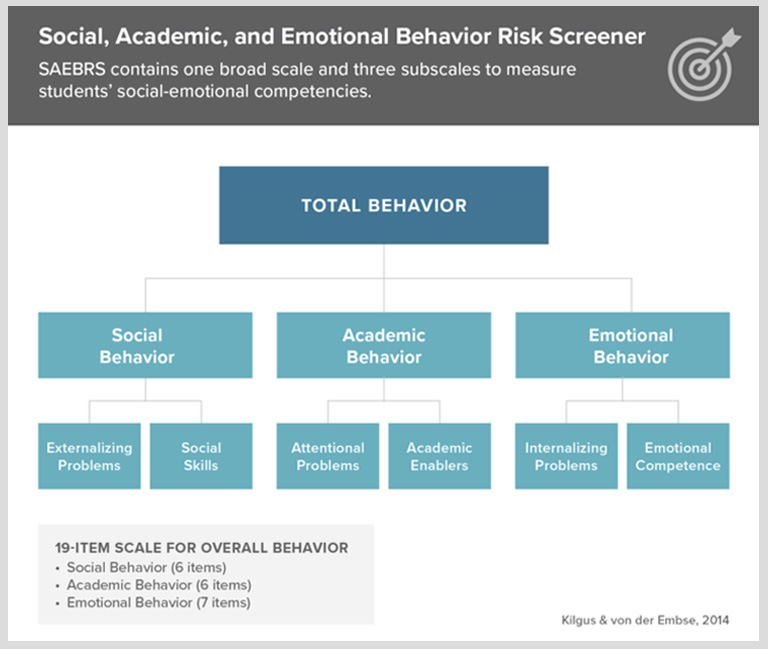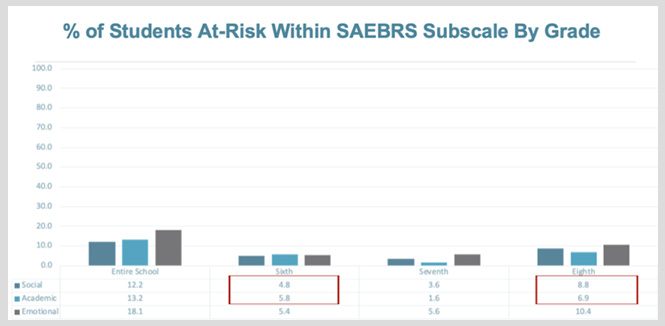April 30, 2021
Screening for social-emotional and behavioral skills is incredibly important for a student’s overall success in school. However, if educators are unsure of what to do with the data once it’s collected, then districts are doing their students a disservice.
Luckily, there are ways to successfully conduct social-emotional behavior screenings and then use the data to create a behavior intervention plan matched to students’ needs.
In this blog, we’ll explain how to:
- Conduct social-emotional behavior screenings
- Analyze students’ screening data
- Create a behavior intervention plan; and
- Utilize the data to support students’ success
What is social-emotional behavior screening data?
Social-emotional behavior competence is essential for positive learning outcomes. We can say that students are exhibiting social-emotional behavior competence when:
- They display certain skills that allow them to get along with adults and peers, as well as navigate classroom contexts.
- They are not displaying problematic behaviors. This can include externalizing behaviors, such as disruptiveness or non-compliance aggression, or internalizing behaviors, such as depression or anxiety.
Accordingly, social-emotional behavior (SEB) screening is a method to detect and monitor signals that indicate whether a student may be delayed in aspects of social-emotional development, such as:
- Communication
- Autonomy
- Affect
- Interacting with others
- Expressing emotions
- Responding to others’ emotions
The purpose behind SEB screening is to accurately inform meaningful next steps or rule out the need for deeper assessments. Next steps often include:
- In-depth social-emotional assessment
- Further monitoring
- Providing interventions when necessary
5 steps to social-emotional behavior screening data analysis & use
To measure social-emotional behavior competence and skills, districts can implement a universal screening tool that is designed to measure SEB functioning. But often, once districts have their data, they’re unsure of how to best analyze and use it, as we noted above.
There is no one answer that will work for every district. However, there are certain protocols that districts can follow to leverage SEB screening data to understand needs and align sustainable, targeted supports to improve student outcomes.
Let’s explore each of these protocols.
#1: Define serviceable base rates
A base rate is the percentage of students who are at risk within a particular environment—whether it’s across the district, within a school, or within an individual classroom.
Serviceable base rates, or SBRs, can be defined as the percentage of students your team thinks they can feasibly support, based upon existing resources and personnel (school psychologists, social workers, etc.). Districts commonly find their SBR is around 20% of students. However, SBRs may vary, with some schools finding that theirs is higher or lower based on available resources.
#2: Examine observed base rates
Once the SBRs have been identified, teams should go through a three-step process to determine whether supports are needed at a school-wide level, class-wide level, or individual student level:
Step 1: If screening data indicate that the percentage of students who are at risk in a school exceeds the school’s SBR (i.e., the observed school-wide base rate is greater than 20%), an initial course of action would be to evaluate actions happening in the universal tier (Tier 1). This may include implementing systematic, school-wide interventions, such as a social-emotional learning (SEL) curriculum or a Positive Behavioral Intervention & Supports (PBIS) framework, or adjusting and refining existing supports.
Step 2: If there is not a school-wide need, the next step is to determine if supports are needed class-wide within each classroom. If a teacher sees that a higher percentage of students are at risk than the SBR (i.e., more than 20%), they can use class-wide strategies that provide support to many students at once, rather than attempting to provide a large number of individualized interventions. Doing so also provides useful additional support to students who may not necessarily be at risk, but who can still benefit from the additional support.
Step 3: After analyzing school-wide and class-wide needs, the last step is to identify individual students who may need either Tier 2 small group or Tier 3 individualized interventions in order to be successful.
This three-step process is represented in following graphic:

#3: Examine subscale scores to align supports
After your team has identified the target for service delivery (school-wide, class-wide, or individual student level), the next step is to examine subscale scores to identify potentially appropriate interventions and supports.
To do this, teams should review the subscores in their SEB screening data to determine if and where the need exists. This will guide the selection of a grade-appropriate, research-based intervention that is designed to support that specific area of need.
Take the Social, Academic, and Emotional Behavior Risk Screener (SAEBRS) from Renaissance as an example. As shown in the graphic below, SAEBRS provides a Total Behaviors score, which is a good indicator of an overall student risk. It also shows how students are doing socially, emotionally, and academically, providing subscores in each domain:

How might you use SAEBRS subscale scores to inform decision making? Consider the following example from a real school district:

The district’s team examined this report and made two decisions based on the data:
- At grade 6, even though emotional risk levels were somewhat elevated, the team focused more on the elevated levels of social and academic behavior problems. This led them to choose particular supports that were appropriate for sixth graders and aligned with social and academic functioning.
- At grade 8, the school had particularly heightened levels of emotional and behavior problems, which led them to choose supports focused on these domains.
It’s important to reiterate that there isn’t a single “right” answer. Instead, it’s about using screening data to guide your understanding of schools, classrooms, and individual students and to inform your next steps.
#4: Integrate screening scores with additional data sources
Of course, additional data can be collected beyond universal screening. Analyzing this data will help teams to determine which course of action is the most appropriate. Some examples include:
School-wide, universal supports (Tier 1):
- PBIS fidelity: Ensure that existing universal supports and PBIS are being delivered with fidelity. You can use many different tools to do this, but the most common ones are Tiered Fidelity Inventory (TFI) and the Benchmarks of Quality (BOQ).
- SEL fidelity: Examine the extent to which the various aspects of social-emotional learning Tier 1 instruction are being implemented. For support, you might consult the CASEL Indicators of Schoolwide SEL Walkthrough Protocol.
School climate data: Consider the possibility that SEB is not improving because the students do not perceive the school to be an effective and supportive environment.
Classroom-level supports (Tier 1): Additional data sources include measures that enable teachers to evaluate themselves with regard to classroom practices, as well as various observation tools and practices.
Individual or small-group intervention and supports (Tier 2 and Tier 3):
- Functional behavior assessments are especially useful when we think contingency management interventions might be in order. They help us discover the “why” behind the problem behavior.
- Research shows that when interventions are function-based, students are more likely to be successful.
Skill assessments: Identify the specific skill gap for each student and help the teachers align a support that is most relevant to the student’s needs.
#5: Identify appropriate interventions and supports
Districts often utilize a multi-tiered system of support (MTSS) framework to help guide appropriate instruction and interventions to ensure students are receiving the support they need to be successful.
As we mentioned at the outset, a behavior intervention plan is a useful tool for identifying and implementing the right supports for each student, so let’s turn our attention there.
Supporting the whole child
Discover tools from Renaissance for effective SEB screening and MTSS management.
What is a behavior intervention plan?
Simply stated, a behavior intervention plan is a document and workflow tool that:
- Drives collaborative, data-informed decision making around identifying students’ social-emotional behavior needs
- Aligns targeted and effective behavior interventions to help students succeed
- Serves as a single source of information to document the need and goal, along with the evidence-based support that will be provided
No matter what a behavior intervention plan is developed for—whether it be Tier 1, small groups, or individual students’ SEB needs—a plan document drives alignment across stakeholders while support is being provided.
Most importantly, the data and information in the plan are key to evaluating the effectiveness of supports and serve as an invaluable resource for guiding decisions in the future.
Information recorded in a behavior intervention plan
Behavior intervention plans can vary from district to district, but they have important features in common. Regardless of local variations, a behavior intervention plan template should include the following key fields:
- The student’s strengths and interests
- The target behavior being supported
- Data that illustrates the target behavior and the skill or motivation that underpins the behavior
- The goal for the student
- The intervention to be implemented, including the strategy name, frequency, duration, and person responsible
- The progress monitoring tool used to measure the effectiveness of the intervention, including the tool’s name and the frequency of administration
How to create a behavior intervention plan
When building a behavior intervention plan, you can create a framework around:
- Multiple behaviors serving the same function
- Common antecedents to the behavior; or
- Individual topographies of behavior
Start by choosing the one that best meets the needs of your learner(s).
Once you’ve chosen the starting point, follow these steps to create the plan:
- Acquire parent or guardian consent.
- Collect baseline data.
- Collect functional behavior assessment data.
- Analyze the data to identify a hypothesized or tested function of the target behavior(s).
- Identify appropriate interventions.
- Assemble plan components.
- Review the plan with everyone necessary, including the parent or guardian.
- Begin to implement the plan.
What makes a behavior intervention plan effective?
An effective behavior intervention plan is marked by several key qualities. Your behavior intervention plan template should do the following:
- Guide problem-solving and promote best practices
- Support efficient data entry and quality data collection
- Match your district’s unique needs
- Evolve over time
Let’s explore each of these points in detail.
#1: Guide problem-solving and promote best practices
A behavior intervention plan should utilize a format that matches the decision making processes of the team. It should be a workflow tool that guides high-quality decisions and follows MTSS best practices.
Consider these behavioral intervention plan examples:
You could include a section in your behavior intervention plan template that reminds your teams to consider whether a Tier 1 need is present before implementing Tier 2 or Tier 3 specialized support.
Or, if your district’s decision making process is intended to incorporate a particular set of data—such as SEB screening data or intervention history data—consider including prompts to attach and summarize those findings. This way, teams are prompted to check the findings and work together to discuss what the data is saying.
#2: Support efficient data entry and quality data collection
Although a behavior plan should ideally house all relevant information for decision making and future reference, manually entering data and narratives can become time-consuming. Instead, streamline the data entry process to save time.
For example, many of the fields in the form can be created as a selection list or dropdown menu, where educators can choose from a set of predefined options instead of manually entering their own. This saves both time and energy from repeatedly typing the same responses, and can also make data cleaner and clearer for reporting purposes.
Moreover, high-quality data platforms will enable data to automatically be pulled into the behavior plan form, such as SEB screening data or student demographic information. To save time, make sure you’ve activated that functionality on your behavior intervention plan template.
#3: Match the district’s unique needs
Make the behavior intervention plan template your own by ensuring it matches your district’s unique needs. Not only does this ensure that the plan is tightly aligned to your processes, but it also creates efficiencies and reduces unnecessary mental load.
For example, you might customize the list of available intervention strategies to match your district’s chosen menu of evidence-based SEB strategies, or customize the list of antecedents to match the common SEB language your team has established.
#4: Evolve over time
Your behavior intervention plan template should be able to evolve over time. Once your team starts implementing plans, there will undoubtedly be changes you’ll want to make.
For example, the template may not be working as effectively as you’d hoped, or there could be a step that is out of order. Maybe you think two fields should be combined into one. Your team might discover that an important problem-solving step is commonly skipped and want to add a new field to prevent that from happening. Whatever it might be, you want to be able to easily make those changes.
A behavior plan template should be designed in a way that accounts for those key steps, eliminating alignment and logistical issues and setting your team up for success.
Renaissance: Providing you with tools to successfully create behavior intervention plan templates and utilize social-emotional behavior screening data
To sum up, much more goes into a student’s overall school success than just academics. Students’ social-emotional and behavioral skills are just as important and play a big role in how they display skills and behaviors.
But in order to know where students fall when it comes to social-emotional behavior, districts must utilize an effective SEB screening tool before implementing interventions.
Renaissance provides districts and their teams with the tools needed to implement successful social-emotional behavior screenings, create behavior intervention plans, and utilize SEB screening data for student success.
Ready to get started? Connect with an expert today to learn more.

